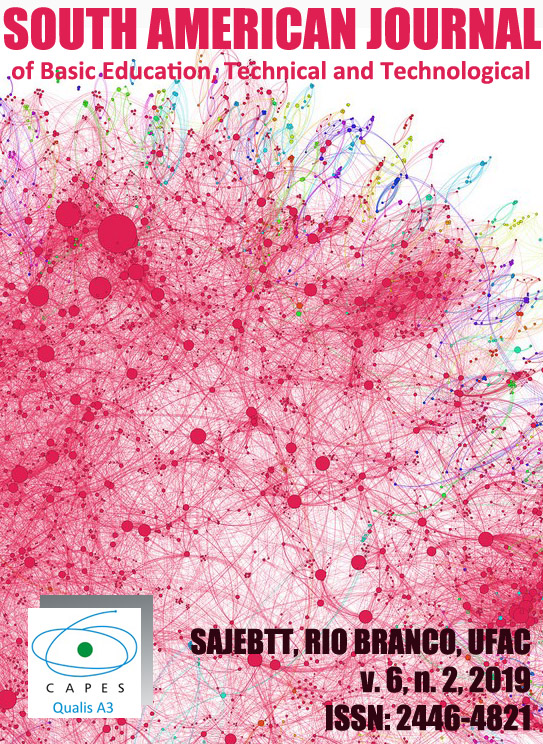Estudo ictioparasitológico de espécies de ambientes lacustres artificiais da bacia hidrográfica do Igarapé Quinoá, Senador Guiomard, Acre, Brazil
Keywords:
Peixes, Parasitologia, Quinoá.Abstract
This work had as aims to analyze the occurrence of parasites in freshwater fish at the artificial lakes in the hydrographical basin of the Quinoá narrow channel, Acre. In the period of January to July of 2013 eighty-eight specimens of freshwater fish of two lakes of the Quinoá narrow channel were analyzed, being thirty-one from Pyrrhulina sp, nine Apistogramma sp, six Australoheros sp, five Acestrorhynchus falcatus, twenty Leporinus sp, nine Hoplias malabaricus and eight Ctenobrycon hauxwellianus. The fishes were submitted to the investigation of parasites that had beginning with the ectoscopy and the necropsy. The gills, eyeball, abdominal cavity and fins were inspected. The gills and eyeball of each captured fish were withdrawed, conditioned in containers of glasses containing formaldehyde 4% for subsequent analysis. The collected ichthyoparasites, fastened in alcohol to 70%, they were put in temporary histological sheets for analysis and visualized under optical stereoscopic microscopy. From seven species of fish studied, three presented parasites. The analyses demonstrated parasitic infestation in H. malabaricus, for Eustrongylides sp, and Contracaecum sp; A. falcatus, for Eustrongylides sp, and Leporinus sp, for Monogeneans species, during the dry period, the months of June and July. It was also observed, to be this the first registration of Eustrongylides sp in A. falcatus.
Downloads
References
2. Balian E V., Segers H, Lévèque C, Martens K. The Freshwater Animal Diversity Assessment: An overview of the results. Hydrobiologia. 2008;595(1):627–37.
3. Luque J. Biologia, epidemiologia e controle de parasitos de peixes. Rev Bras Parasitol Veterinária [Internet]. 2004;13(1):161–5. Available from: http://www.ufrrj.br/laboratorio/parasitologia/arquivos/publicacao/48_LIVRO.pdf
4. Coutant CC. What is “normative” for fish pathogens? A perspective on the controversy over interactions between wild and cultured fish. J Aquat Anim Health. 1998;10(2):101–6.
5. THATCHER VE. Amazon Fish Parasites. Amazoniana. 1991;11(3–4):263–571.
6. Eiras JC, Takemoto RM, Pavanelli GC. Métodos de estudo e técnicas laboratoriais em parasitologia de peixes. 2006. p. 199 p.
7. ODUM EP. Ecologia. Guanabara, editor. Rio de Janeiro RJ; 1985. 434 p.
8. LUDWIG JA, REYNOLDS J. Statistical Ecology: a primer on methods and computing. John Wiley. Nova York; 1988. 337 p.
9. Margolis L, Esch GW, Holmes JC, Kuris AM, Schad GA. The Use of Ecological Terms in Parasitology (Report of an Ad Hoc Committee of the American Society of Parasitologists). J Parasitol. 1982;68(1):131.
10. ROBERTS RJ. Patología de los peces. Mundi-Prensa, editor. Madrid; 1981. 366 p.
11. Thatcher VE, Brites Neto J. Diagnostico, prevenção e tratamento das enfermidades de peixes neotropicais de agua doce. R Bras Med Vet. 1994;16(3):111–28.
12. Mackenzie K, Williams HH, Williams B, Mcvicar AH, Siddall R. Parasites as Indicators of Water Quality and the Potential Use of Helminth Transmission in Marine Pollution Studies. Vol. 35, Advances in Parasitology. 1995. 85–144 p.
13. Ciganovich EA, Redman PJ. Field Manual of Wildlife Diseases. General Field Procedures and Diseases of Birds. U.S. Geolo. World. Washington DC; 1999.
14. CHUNG H-Y, MAN SY, YI-HSIUNG L, KOU G-H. Larval Eustrongylides (Nematoda: Dioctophymatidae) Occurred in Rice-Field Eels (Flutaalba). Fish Dis Res. 1985;COA Fisher(4):38–44.
15. Barros LA, Moraes Filho J, Oliveira RL. Larvas de nematóides de importância zoonótica encontradas em traíras (Hoplias malabaricus bloch, 1794) no município de Santo Antonio do Leverger, MT. Pathology. 2007;59(2):533–5.
16. MULLER MI, MADI RR, UETA MT. Fauna helmíntica de Hoplias malabaricus (Bloch, 1794) nos tanques da fazenda das pedras, Campinas, SP. In: ENBRAPOA, editor. ENBRAPOA, 8, 2004 Anais. Laguna SC; 2004. p. 34.
17. EIRAS JC, A.A R. Histopatologia em peixes resultantes de infecções parasitárias. Publicações do Inst Zool Dr Augusto Nobre. 1989;208:1–2.
18. M.L. M, ONAKA EM, FENERICK Jr. J. Larvas de Contracaecum (Nematoda: Anisakidae) em Hoplias malabaricus e Hoplerythrinus unitaeniatus (Osteichthyes:Erythrinidae) de importância econômica no estado do Maranhão. In: EMBRAPOA, editor. EMBRAPOA, 8, 2004 Anais. Laguna SC; 2004. p. 25.
19. PAVANELLI GC, EIRAS J da C, TAKEMOTO RM. Doença de Peixe profilaixa, diagnostico e tratamento. Embrapa-. Parnaiba; 1998.
20. Carvalho AR, Martins RT, Bellei PM, Lima S de S. Aspectos ecológicos da helmintofauna de Hoplias malabaricus (Bloch, 1794) (Characiformes, Erythrinidae) da Represa Dr. João Penido (Juiz de Fora-MG, Brasil). Rev Bras Zoociências. 2017;18(1):7–20.










